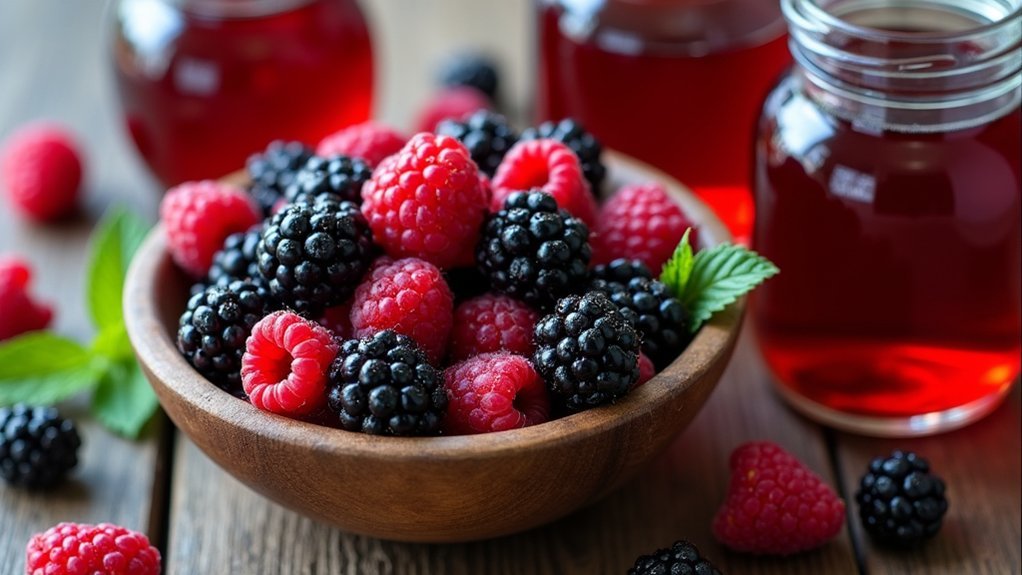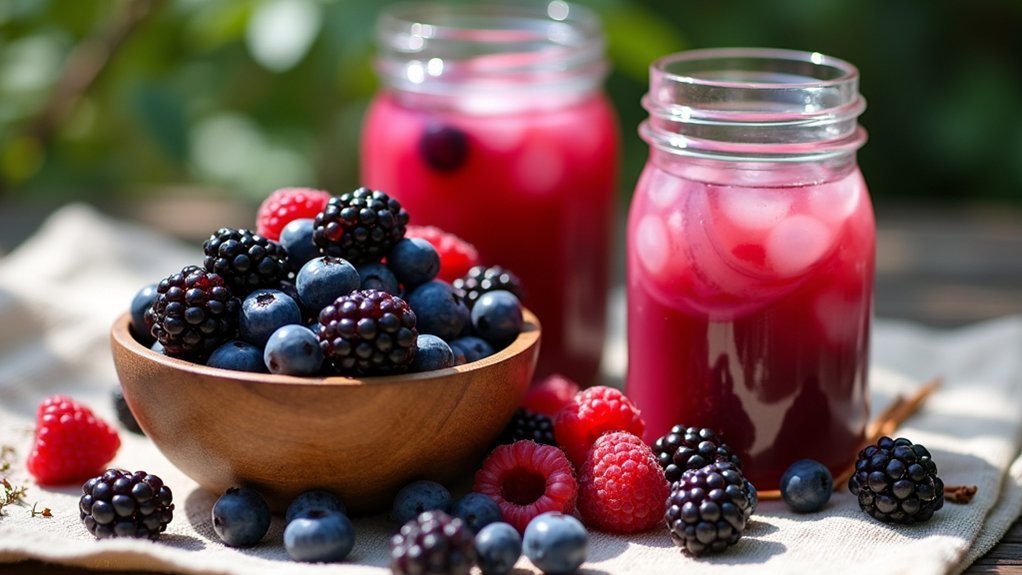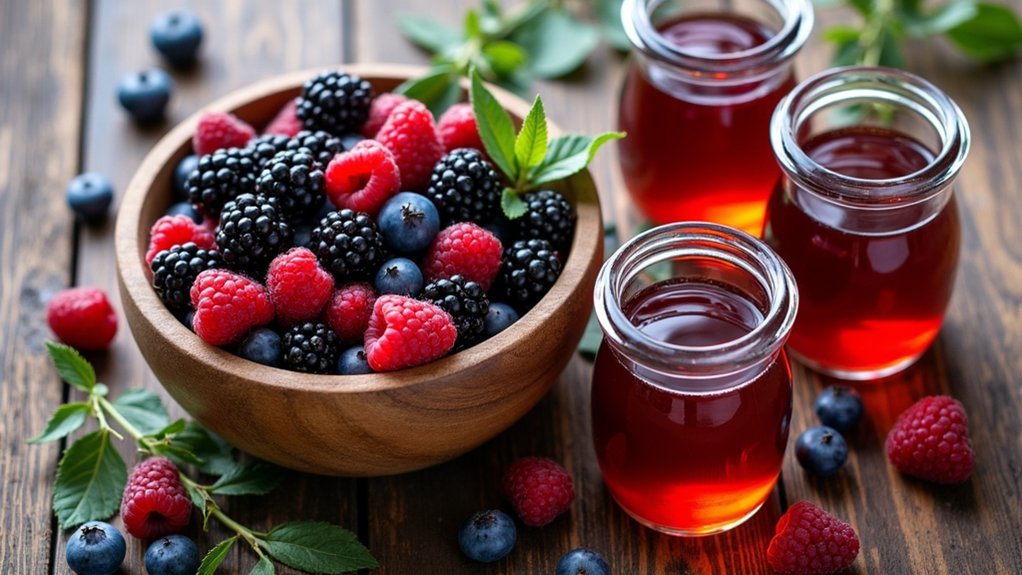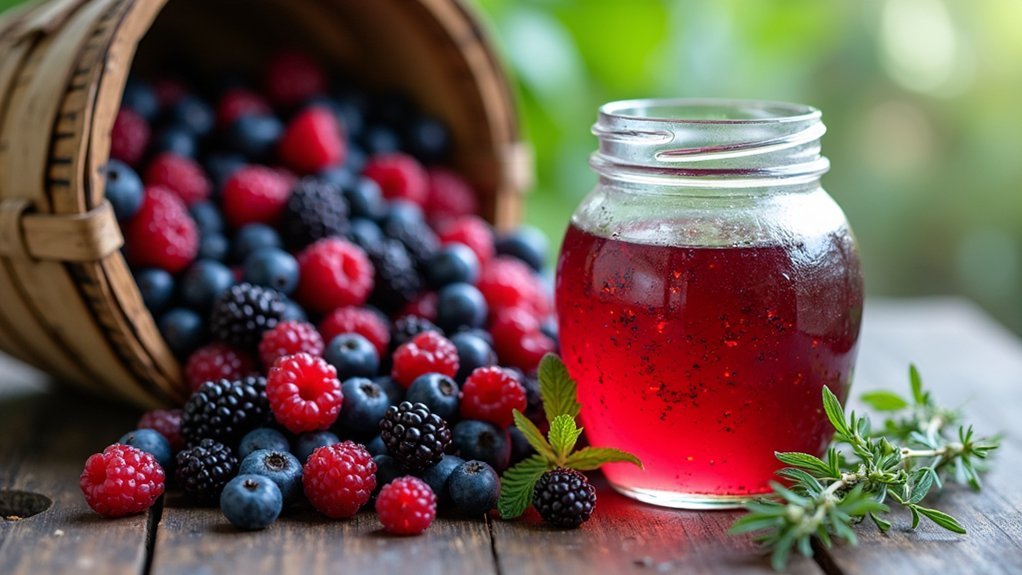You can make wild berry vinegar through traditional cold infusion (3-4 weeks steeping), quick-heat extraction (10-15 minutes warming), or the double berry loading process for deeper flavor. Select ripe berries, rinse thoroughly, and decide between infusion or fermentation based on your timeline. Store your creation in glass containers away from light, and consider aging 3-6 months for complex flavors. The right technique will transform your culinary creations from ordinary to extraordinary.
Traditional Cold Infusion Method

While many vinegar infusion techniques exist, the traditional cold infusion method stands as the most dependable way to capture delicate berry flavors.
The cold infusion method remains unrivaled for preserving the essence of berry flavors in artisanal vinegars.
You'll want to combine fresh berries with high-quality vinegar, preferably white wine vinegar, which preserves clarity and enhances your final product.
The ratio for the cold infusion method is straightforward: one part berries to two parts vinegar. This guarantees sufficient acidity to extract flavors safely and effectively.
Simply mix your ingredients, then store the mixture in a cool, dark place for 3-4 weeks.
After the infusion period, strain out the solids to prevent cloudiness.
This technique works wonderfully with various wild berries, though darker fruits like blackberries and cherries will yield the most robust results in your berry vinegar.
Quick-Heat Extraction Technique
When using the quick-heat extraction technique, you'll need to maintain temperatures below boiling to protect both the vinegar and berry compounds.
You should heat your berry-vinegar mixture for exactly 10-15 minutes, as insufficient time won't extract enough flavor while overheating can damage the delicate notes.
Watch for visual cues like slight color changes and the release of berry aromas, which indicate your infusion has reached the ideal extraction point.
Safety First Approach
Although wild berries can infuse vinegar naturally over time, the Quick-Heat Extraction Technique offers a safer alternative that eliminates potential pathogens while accelerating the process.
When you make fermented vinegar with wild fruit, heat treatment provides essential protection against harmful bacteria that might be present on foraged berries.
Set up a double boiler rather than heating your vinegar directly. The water bath method guarantees your mason jar contents never reach boiling point, which would destroy delicate flavors.
Maintain gentle heat for 10-15 minutes, stirring occasionally to release the fruit's essence into the vinegar. Unlike room temperature infusions that might harbor contaminants, this controlled heating purifies while preserving nutritional benefits.
After cooling completely, strain your infusion and store in a sealed container away from light. This technique balances safety with peak flavor extraction.
Timing Is Everything
Building on our safety protocols, let's now focus on the time-saving power of heat extraction. The quick-heat extraction technique dramatically cuts your infusion time from days to just 30 minutes, while preserving delicate berry flavors.
Gently heat your vinegar to approximately 140°F (60°C)—never boiling—and add your berries to begin the rapid infusion process. This controlled temperature coaxes out the essence of the berries without cooking away their vibrant characteristics.
For the best berry-infused vinegar, select fresh seasonal berries at their peak ripeness. The flexibility in berry selection invites creative combinations—mix strawberries with basil or blackberries with thyme for unique flavor profiles.
This method not only saves time but also allows you to experiment with seasonal harvests throughout the year.
Double Berry Loading Process

You'll achieve deeper flavor complexity in your berry vinegar by employing the two-stage infusion technique.
First, steep fresh berries in quality white wine vinegar for several days, then strain and replace with a new berry batch for another few days.
This double loading method maximizes flavor extraction by utilizing both batches of fruit while preventing cloudiness in your finished vinegar.
Two-Stage Infusion Technique
For those seeking to intensify berry flavors beyond standard infusion methods, the two-stage technique delivers remarkably complex results. This approach extracts maximum flavor by using two separate berry batches with one base.
Begin by combining fresh seasonal berries with white wine vinegar and allowing them to macerate for four days. After removing this first batch, immediately add fresh berries to the already flavored liquid for another four-day infusion. This double loading process extracts additional flavor compounds, creating a deeper, more nuanced flavor profile.
Once complete, strain and bottle your berry-infused vinegar, yielding approximately two cups of product. The finished vinegar showcases both sweet and tart notes while maintaining a vibrant color that looks stunning in clear bottles – a demonstration of the enhanced extraction this technique provides.
Enhanced Flavor Extraction
While traditional infusion methods produce adequate results, the double berry loading process dramatically intensifies flavor profiles in wild berry vinegars.
When you make vinegar using this technique, you'll extract maximum flavor through sequential infusions.
Start by macerating your first batch of wild berries in vinegar for four days, then strain and repeat with fresh berries. This double loading guarantees each drop of your fruit vinegar captures the full complexity of the berries.
You'll need a generous amount of wild berries, though exact quantities can vary based on what's available to you.
Adding a splash of cognac to your infusion process is vital—the alcohol helps extract the fermented fruit's natural essence.
This systematic approach yields a vibrant vinegar with enhanced flavor extraction that far surpasses single-infusion methods.
Wild Berry Selection & Preparation
When foraging for your DIY vinegar infusion, selecting the right wild berries makes all the difference in creating a vibrant, flavorful end product. Look for ripe, juicy blackcap raspberries, blackberries, and elderberries that will release their distinct flavors during the infusion process.
Once you've gathered your wild berries, thoroughly rinse them to remove any dirt or insects. Fill your canning jar halfway with the clean fruit—this generous amount guarantees a rich flavor profile.
Gently crushing the berries before adding them to your vinegar releases their natural juices and enhances the final taste.
Always store your prepared berries in a cool, dark location throughout the infusion process to maintain freshness and prevent spoilage.
Proper preparation is the foundation of a successful wild berry vinegar that captures the essence of your foraged treasures.
Fermentation vs. Infusion Approaches

The two primary methods for creating wild berry vinegar offer distinctly different flavor profiles and brewing experiences.
With infusion, you'll steep fresh berries in vinegar for three to four weeks, extracting vibrant flavors quickly. This technique works beautifully with dark fruits like blackberries and cherries, yielding sweeter homemade vinegars that maintain the berries' original character.
Fermentation, meanwhile, harnesses natural yeasts to transform fruit sugars into alcohol before converting to vinegar. This process takes longer—typically three to six weeks—but rewards your patience with complex flavors and potential health benefits.
Your fermented vinegar will develop a distinctive tanginess from the acetic acid produced. Juicy fruits like apples and grapes excel in fermentation, though any berry can work with either method depending on your desired flavor outcome.
Flavoring Enhancements & Variations
Now that you've mastered the basic methods, let's explore how to elevate your wild berry vinegar with creative additions.
Combine different berries like blackcap raspberries and wild plums to create complex flavor profiles that balance sweetness and acidity.
Apple cider vinegar makes an excellent base for berry infusions, providing a mellow backdrop that lets fruit flavors shine.
The humble apple cider vinegar steps back as a supporting character, allowing wild berries to take center stage in your infusions.
Try adding herbs such as thyme or basil during the infusion process for aromatic notes that complement the berries' natural tartness.
For a sweeter result, incorporate honey after straining—it softens acidity while adding depth.
The double infusion technique delivers more intense flavors; simply replace spent berries with fresh ones halfway through the process.
This method works particularly well with delicate berries that might otherwise become lost in the vinegar's sharpness.
Storage Solutions & Aging Tips

Properly stored wild berry vinegar can transform from a simple kitchen concoction into a complex culinary treasure over time. Store your fruit scrap vinegar in clean glass containers away from sunlight to maintain quality for up to two years. Always strain thoroughly to remove berry pieces that could cause cloudiness.
| Storage Type | Aging Tips | Culinary Applications |
|---|---|---|
| Cool Cellar | Check for fermentation signs | Vibrant salad dressings |
| Dark Cabinet | Use heavy paper bags for darkness | Complex marinades |
| Basement Shelf | Age 3-6 months minimum | Gourmet reductions |
Remember to regularly inspect your vinegar for bubbling or pressure, which indicates ongoing fermentation. A well-aged wild berry vinegar develops deeper flavor notes that elevate everyday cooking to gourmet status. The patience you invest in proper storage yields remarkable culinary versatility.
Frequently Asked Questions
What Vinegar Is Best for Cleaning Berries?
For cleaning berries, use white vinegar diluted in water (1:3 ratio) or apple cider vinegar. You'll want to avoid strong or flavored vinegars that might affect taste. They'll remove pesticides and bacteria effectively.
What Is the Best Way to Infuse Vinegar?
To infuse vinegar best, steep fresh fruits in high-quality white wine vinegar for 3-4 weeks in a cool, dark place. You'll want to shake it gently every few days and strain afterward for ideal flavor extraction.
How to Make Blackberry Vinegar for Coughs?
To make blackberry vinegar for coughs, mix fresh blackberries with equal parts apple cider vinegar and honey. Let it infuse for three weeks, strain, and take a tablespoon diluted in warm water daily.
How to Keep Berries Fresh Longer With Vinegar?
To keep berries fresh longer with vinegar, soak them in a 1:3 vinegar-water solution for a few minutes. Rinse thoroughly, dry completely, and store in a breathable container in the refrigerator. You'll enjoy fresh berries for weeks!
In Summary
With these seven wild berry vinegar methods, you'll create vibrant homemade concoctions that rival store-bought versions. Whether you're using cold infusion for delicate flavors or double loading for intensity, you've now got the skills to transform foraged berries into culinary treasures. Remember to experiment with your own flavor combinations and enjoy watching your vinegars develop character as they age. Happy foraging and fermenting!





Leave a Reply